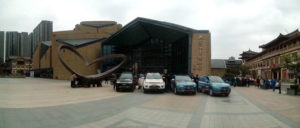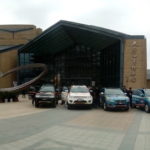Making of an Urban Spectacle
In 2013, I first stepped into the Tang West Market Museum in Xi’an. This museum, situated in the historical Tang Dynasty (618-907 C.E.) West Market site, is China’s first heritage museum run by a private corporation specializing in real estate and cultural business. Lü Jianzhong, CEO of the museum, identifies the museum as the cultural core (wenhua hexin) of his enterprise. Formerly known as Chang’an, Xi’an is recognized as one of the starting points of the Silk Roads by the Chinese government and the UNESCO World Heritage Center. As early as the 1980s, the local government began to promote heritage-related tourism for economic development (Zhu and Yang 2016). Noticeable changes took place during the 2000s when the government further allowed privatized corporations to manage heritage sites.
In 2016, however, two archaeologists Zhang Jianlin and Gong Guoqiang publicly voiced their concerns about the West Market site’s third phase of development. They pointed out that the corporation had not notified the archaeological team in advance about their excavation work, which could have severe consequences for the heritage site. If the same development model were replicated for other privately funded Silk Road–related sites, the archaeologists suggested that more precautions be taken to balance heritage preservation and real estate development (Gong and Zhang 2016). Thanks to the intervention of archaeologists and heritage workers, the development project was halted for further inspection. This incident also reflects the deep-seated conflicts between profit-making and preservation as the city undergoes constant development.

A panoramic view of the northwestern section in the Tang West Market complex, featuring the museum (center), residential buildings (left), and commercial building (right). Jing Wang
This double binding of culture and business not only brings the destructive force of neoliberalism to the forefront; it also produces new urban spectacles. The chief architect Liu Kecheng, the Dean of the School of Architecture in the Xi’an Architecture and Technology University, is well known for his hybrid use of classic Chinese and modernist styles. While the heritage museum takes the modernist outlook made from high-vault glass ceiling and corridors, the surrounding buildings feature a neoclassical Chinese style with dark blue tiles, white and grey walls, temple-shaped roofs, and overhanging eaves. This reversal of temporalities in architectural representation reminds us of Guy Debord’s conceptualization of modern spectacles. “Reality rises within the spectacle,” Debord writes, “and the spectacle is real.” The reality of capital accumulation is revealed and accentuated through the heritage site expanded into an urban spectacle.
From Spectacle to Neoliberal Reality
By tracing the multifaceted practices in a heritage site, this essay shows the neoliberal forces to privatize the Silk Road in the Chinese cities. It highlights the private corporations’ voluntarism to manage heritage sites and develop real estate. It also attends to the limits of privatizing the heritage economy through urban spectacles. While heritage becomes a brand, the need to preserve is often trumpeted in a performative fashion. However, we cannot overlook the critical role of the post-socialist state in these processes.
During a speech in Kazakhstan in 2013, the People’s of the Republic of China President Xi Jinping proposed reviving the ancient Silk Road and expanding it into economic and geopolitical networks between China and Central Asia. Since then, the Chinese government has been promoting the Road and Belt initiative (yi dai yi lu, or R&B) at the state level as a nation-building schema involving cultural diplomacy and economic policies across Asia, Europe, Africa, and Latin America. As a result, the Chinese state has invested massively in the foreign financial loans and infrastructure projects. It is in that year that the Tang West Market complex was further branded the “commercial starting point of the Silk Road.”
While Beijing deploys the R&B initiative as a geopolitical imaginary for international networks, such policies also heavily impact the ways in which local practices adapt to the initiative. Among different efforts to privatize the Silk Road, the physical remains of heritage sites become key spaces where local actors deploy a neoliberal logic to blend heritage management and business development. In Xi’an, where the Tang West Market Museum is located, this shows how the past and present reinforce one another.
In post-socialist China, the historical metaphor and physical remains of the past have been corporatized, commodified, and spectacularized as a neoliberal reality. As Jean and John Comaroff point out, the “rise of neoliberalism” tend to “encourage the outsourcing of the functions of state to the private sector” (2009, 120). This outsourcing includes the cultural heritage management through real estate development and the tourist industry, and results in the emergence of new urban spectacles predicated upon the dual use of the past, mirroring the neoliberal expansion of capital abroad.
Jing Wang is a PhD candidate in the Anthropology Department at Rice University and currently a visiting scholar in the Anthropology Department at the University of Pennsylvania. Her research interests include globalization, nationalism, memory, Muslim minorities, diaspora, heritage, media, and cities in contemporary Asia.
Please contact Shuang Frost (shuanglu@fas.harvard.edu) and Heidi Lam (heidi.lam@yale.edu) with your essay ideas and comments.
Cite as: Wang, Jing. 2019. “Privatizing the Silk Road in Contemporary China.” Anthropology News website, January 24, 2019. DOI: 10.1111/AN.1067
Copyright [2019] American Anthropological Association


